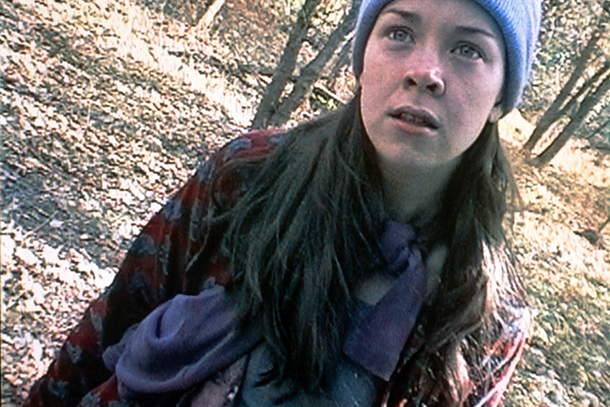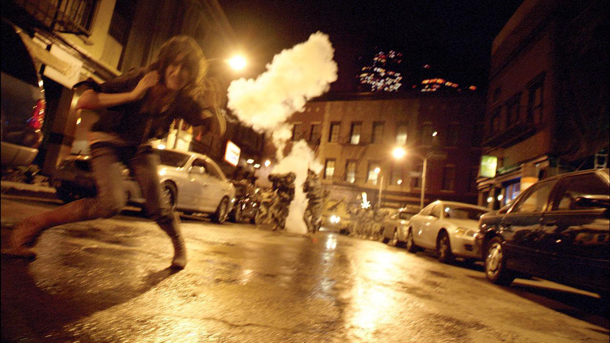
Do you remember when The Blair Witch Project came out and there was all that unexpected hoo-hah about how the camerawork was making people feel sick? I never got to see the film on the big screen (too scary) but I watched it on DVD a few months later and found myself baffled that anybody could watch some rubbish wobbly camerawork and lose their lunch over it.
“Lightweights,” I thought. “Idiots. I bet they wouldn't even feel sick if there hadn't been so much publicity about it. They just want to look cool by jumping on the bandwagon. Silly sods.”
Oh foolish, foolish me. How I regret those words now. How terrible I feel for my lack of sympathy. A few years later I had an ear infection – nothing major, just a touch of labyrinthitis: a common condition and nothing to worry about. However, by the time it had gone it had changed the inner workings of my lugholes forever. Now I just have to read the words “hand-held camera” and I throw up in my mouth a little. Now I, too, am on that bandwagon. I am one of the vomity masses.
I first experienced it during Cloverfield , easily my worst cinema experience of all time. Half an hour into the film my stomach started doing this weird little rhumba inside my belly. I had to hang on to the armrests of my seat because I felt like I was swaying. I watched with a growing feeling of nausea, baffled that so many scenes could pass in which nobody ever set the camera down on a shelf or a table – why did they have to hold the damn thing all the time? Why was the lens always waving in the air? The feeling got worse and worse until, finally, I had to choose between closing my eyes for a huge chunk of the action or sprinkling everybody in my immediate vicinity with half-digested food.
I'm not exaggerating. People with movie motion sickness, contrary to my original beliefs, do not exaggerate. This is very important; we're not making this up, or looking for attention, or trying to sound “cool”. I sat in the middle of a West End cinema while a monster stomped the hell out of New York in front of me and all I could think was, “I'm in the centre of a row, I'll never make it to a toilet in time. What if I throw up in my bag? Is there anything valuable in there? Could I barf in my purse and get away with it? What if it overflows? ...Oh my god, how has it come to this?”
To my relief, the couple sitting in front of me got up to leave just as I was at my sickest – the woman had spent the past 20 minutes bent over with her head on her knees, so I knew I wasn't alone with my pukiness – and I knew I could vomit on their empty seats if necessary. Thankfully, though, because of my closed eyes, I survived to the end of the film. I still have no idea how Cloverfield ended, although I'd guess it ended with a lot of swaying, waving and jolting because the cameraperson was a sadist.

The same thing happened when I went to see The Bourne Ultimatum, no doubt helped along by the huge bag of Skittles I scoffed during the first ten minutes, before the whip-fast shakycam filming brought on the nausea. (I've never looked at a Skittle since.) I was so poorly during a screening of found-footage film The Dinosaur Project that I came out of the cinema and had to sit on the kerb in a Soho street to recover, thinking I was going to faint. It's a good thing I'd read The Hunger Games before I saw it because I had my eyes closed for all the action scenes yet still managed to keep up with the plot. District 9 , which I thankfully watched on TV, was viewed in ten-minute chunks because even on the small screen it was unbearable. At least I could turn it off and take a break – you can't do that at the cinema.
Sign up to the SFX Newsletter
Get sneak previews, exclusive competitions and details of special events each month!
My point is that motion-sickness is real. Pooh-poohing someone for getting sick watching hand-held camerawork is not only rude, it's cruel. Some of us have inner ears that fear all things wobbly; some of us have eyes that think what we're watching is real, and if what we're watching is swaying... well, then our brain thinks we're on a boat. And boats make us seasick! We're not wimps or hypochondriacs. We're people with an affliction, and a totally understandable one; a sensitive inner ear that we can't control. It's also more common than you'd think: we're not just a few precious flowers, we're a veritable army of pukers-in-waiting.
But it's an affliction that can be avoided, and this is why I'm angry about it. Hand-held camerawork is great for a few minutes – it adds urgency to a scene, or a sense of realism, and it's part of the way stories are told on a screen. When it becomes a full-time part of the action, however, it's unnecessary and distracting. I'd argue that the hand-held cameras in The Blair Witch Project were the first and only time they have been successful, in that the idea was new back then (hell, the concept of “found footage” was new back then – quite why people are still making these films after 13 bloody years is astonishing). Every piece of wobbly, grainy, horizon-tilting cinematic torture since then has been superfluous.
If you're going to use it, filmmakers, at least make sure your characters place the camera down every now and then so that us up-chuckers can take a rest and recover our (literal) equilibrium. If you don't, you have no idea what hell you're putting us through. It's the same feeling you had as a kid when you'd been on a playground roundabout for too long, and you get off and everything is spinning... but rather than laughing and falling over, you're stuck in a cinema seat and You. Are. Going. To. Puke.
Nobody wants to spew in their local fleapit. Nobody should have to feel as though they're going to. Nobody should live in fear that the person behind them is going to cover them in upchuck. And this insistence on dizzying camerawork, whether it's a camcorder discovered by a search party or a director showing off his fancy moves (damn you, Paul Greengrass) is taking the fun out of movie-going. I couldn't see the latest Bourne film because I knew the camerawork would emulate the previous movies and I didn't fancy decorating the ODEON with little pieces of carrot. I had to watch Chronicle on DVD so I could pause it and look at things that weren't swaying for a while. As for Life Of Pi – a film set on a boat? Bobbing up and down in the middle of the ocean? Don't think I'll be risking that one, thanks. (Admittedly, the swaying camerawork in that film is probably rather unavoidable.)
What we need is a warning system: a sign you read before you buy a cinema ticket which says, “May cause motion-sickness!” Only then will I feel confident enough to go and see a film without worrying about my lunch making a sudden re-appearance.
Then again, people have known for decades that strobe lighting can cause epileptic fits, and I don't recall ever seeing a warning before a film for that. If that isn't proof that filmmakers don't give a damn about making their audiences suffer, I don't know what is. I mean, come on: how hard is it to warn for something that will make people ill? How hard is it to avoid triggering this stuff in the first place? Show some compassion! This isn't a rare malady, guys!

There's only one good side-effect of having movie motion-sickness: you can judge a good film from a bad film far more easily. If you've spent an entire movie swallowing down bile and you can come out and still announce that you enjoyed the film... well, that was one HELL of a good film. Beasts Of The Southern Wild i s, to date, the only film that holds this distinction for me (although I did enjoy Cloverfield as well, up until the nausea started). I wanted to throw up all the way through Beasts , yet I still loved it to death, despite the vomity aftertaste. Someone should whip up an Oscar for this kind of thing.
Final note: there's a handy website called http://movie-hurl.com/ which rates films according to their motion-sickness factor; the nearest we can get to an official warning before entering the cinema.
Unsurprisingly, The Blair Witch Project is at number one.
Jayne Nelson
SFX Magazine is the world's number one sci-fi, fantasy, and horror magazine published by Future PLC. Established in 1995, SFX Magazine prides itself on writing for its fans, welcoming geeks, collectors, and aficionados into its readership for over 25 years. Covering films, TV shows, books, comics, games, merch, and more, SFX Magazine is published every month. If you love it, chances are we do too and you'll find it in SFX.


